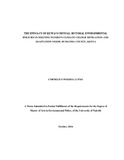| dc.description.abstract | The impacts of Climate change affect various people in the society in different ways. The effects project differently among the different sections of the community such as the old, the young, women and men. Various studies carried out have shown that women in particular suffer much more from the disasters associated with climate change than men. This is largely due to their vulnerability, a complex interaction between poverty and gender relations which often makes women poorer than men in many societies. When consequences of climate change are not adequately addressed, women are deprived further and this creates the need for action at policy level to mainstream their affairs for better adaptation and mitigation against the effects of climate change. This calls for policy-makers to place women affairs at an elevated level of importance during formulation of key policy documents to help them adapt to and mitigate against the impacts of climate change effectively. It is critical that such policies take into account the interests of women at all the stages of their development. Kenya has several sectoral environmental policy documents that are perceived to be relevant in addressing climate change, sustainable development and environmental issues. However, their efficacy in aiding women adaptation and mitigation against the effects of climate change remains untested. The aim of this study therefore was to examine the provisions of the Forest Policy, the Water Policy and select sub-sector policies in agriculture, to determine their efficacy in addressing the climate change adaptation and mitigation needs of women in Bungoma County. From results of the study, appropriate recommendations were given on how to make the policies more efficacious. The study area was Bungoma County in the Western part of Kenya. Both primary and secondary data was used in this study. The sampling design method chosen for the study was non-probability. Through both purposive and quota sampling, 900 participants were selected from the County. Primary data was collected using questionnaires from the respondents. Interviews were carried out with key informants and focus group discussions. This was to deduce the knowledge and perceptions of the respondents on climate change impacts on women, the corresponding environmental polices available in addressing these impacts as well as their efficacy. Secondary data was collected through review of the existing literature in order to obtain
xiii
relevant information. Kenya’s Forest Policy, Water Policy and select sub-sector policies in Agriculture were examined as well as other relevant international, national and local policies and action plans relevant to the study. The data collected was analysed using appropriate tools, the SPSS and presented according to the various themes in the form of discussions, tables and charts. The study findings revealed various consequences of adverse climatic conditions affecting women in Bungoma County. In order of importance they are as follows: diseases, 67%, food security, 61%, soil erosion, 45%, drought conditions, 15%, massive flooding 12%, unprecedented cold spells 9%, while others were at 9%. It also deduced that critical sectoral environmental policies are not efficacious enough to aid women adaptation and mitigation against the adverse climate change effects. Thus, there is need to review the various policies to enhance their efficacy in climate change adaptation and mitigation needs for the women in Bungoma County | en_US |



